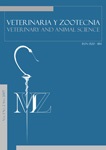Autores/as
Resumen
RESUMEN: El experimento fue conducido para determinar los efectos de la suplementación con selenio orgánico en los parámetros hemáticos y calidad de la carne de cerdo. La investigación se realizó en la Universidad de Caldas a 1010 msnm, con una temperatura promedio de 22,8°C y humedad relativa de 76%; se utilizaron 18 cerdos, los cuales fueron divididos en dos tratamientos cada uno con tres repeticiones, conformada por tres cerdos (dos hembras y un macho) con un peso inicial promedio de 70 kg. El tratamiento 1: cerdos alimentados con 0,30 ppm a partir de selenio inorgánico (selenito de sodio), y el tratamiento 2: cerdos alimentados con 0,30 ppm a partir de selenio orgánico (Prokel SelenioTM). Los resultados fueron sometidos a análisis de varianza. Se determinó que los cerdos alimentados con selenio orgánico generaron menor pérdida por goteo a las 24, 48 y 72 horas de almacenamiento de la canal. Se evaluaron los parámetros sanguíneos y la incidencia de los tratamientos sobre las características sensoriales de la carne, no encontrándose diferencias estadísticas (P>0,05).
Palabras clave
Citas
Ellis, M.; McKeith, F. Nutritional influences on pork quality. National Pork Board/ American Meat Science Association Fact Sheet, 1999.
Goehring, T.B.; Palmer, I.S.; Olson, O.E. et al. Effects of seleniferous grains and inorganic selenium on tissue and blood composition and growth performance of rats and swine. Journal Animal Science, v.59, p.725-732, 1984.
Gunenc, A. Evaluation of pork meat quality by using water holding capacity and vispectroscopy. Quebec, Canada: McGill University, 2007.
Tesis (Maestría Department of bioresource engineering). Janz, J.A.; Morel, M.; Purchas, P.C.H. et al. The influence of diets supplemented with conjugated linoleic acid, selenium, and vitamin E, with or without animal protein, on the quality of pork from female pigs. Journal Animal Science,v.86, p.1402-1409, 2008.
Jonsall, A. Sensory quality of pork. Influences of rearing system, feed, genotype, and sex. Suecia: Uppsala university, 2000. Tesis (Doctorado in deparment of domestic sciences). Little, T.; Hills, J. Métodos estadísticos para la investigación en la agricultura. México: Editorial Trillas S.A., 1976.Lyon, et al. Effects of diet an feed withdrawal on the sensory descriptive and instrumental profiles of broiler breast fillets. Poultry Science, n.83, p.275-28, 2004.
Mahan, D.C.; Cline, T.R; Richer, B. Effects of dietary levels of selenium enriched yeast and sodium selenite as selenium sources fed to growingfinishing pigs on performance, tissue selenium, serum glutathione peroxidase activity, carcass characteristics and loin quality. Journal Animal Science, v.77, p.2172-2179, 1999.
Mahan, D.C.; Parrett, N.A. Evaluating the efficacy of selenium-enriched yeast and sodium selenite on tissue selenium retention and serum glutathione peroxidase activity in grower an finisher swine. Journal of Animal Science, v.74, p.2967- 2974, 1996.
Mateo, R.D.; Spallholz, J.E.; Elder, R. et al. Efficacy of dietary selenium sources on growth and carcass characteristics of growing-finishing pigs fed diets containing high endogenous selenium. Journal of animal science, v.85, p.1177-1183, 2007.
Mikulski, D.; Jankowski, J.; Zduńczyk, Z. et al. The effect of selenium source on performance, carcass traits, oxidative status of the organism ,and meat quality of turkeys. Journal of Animal and Feed Science, v.18, p.518-530, 2009.
Muñoz, A.; Garrido, M.D.; Granados, M.V. Analisis de las perdidas por exudacion en cerdos alimentados con un suplemento de selenio organico y vitaminas E y C en dietas de engorde. Anales de veterinaria, Universidad de Murcia, v.13-14, p.65-70, 1997-98.
Nielsen, S. et al. Sensory emphasis on pork quality related to the diet content of fermeable fibrerich feedstuffs (chicory and lupine) with special emphasis on the effect on boar taint. 2007. Disponible en: http//orgprints.org/12059 Accesado en: 22/04/2011. Nollet, L.M.L.; Toldra, F.; eds. Handbook of muscle
foods analysis. Boca Ratón, Florida, USA: CRC Press, 2009.
NPPC Pork quality solution team. Pork quality targets. National pork board, 1998. Instituto Colombiano de Normalización y Certificación. Analisis sensorial. Métodos del perfil de sabor. NTC 3929. Bogotá, Colombia.
________. Analisis sensorial. Identificacion yselección de descriptores para establecer un perfil sensorial por una aproximación multidimencional. NTC 3932. Bogotá, Colombia.
Perić, L.; Milošević, N.; Žikić, D. et al. Effect of selenium sources on performance and meat characteristics of broiler chickens. Journal Applied Poultry Research, v.18, p.403-409, 2009.
The National Research Council-NRC. Nutrients requirements of swine. 10th revised edition.
The National Academies Press, 1998. Walshe, B. et al. Composition, sensory and shelf life stability analyses of Longissimus dorsi muscle from steer reared under organic and conventional production systems. Meat Science, n.73, p.319-325, 2006
Wang, Z.G.; Pan, X.J.; Peng, Z.Q. et al. Methionine and selenium yeast supplementation of the maternal diets affects color, water-holding capacity, and oxidative stability of their male offspring meat at the early stage. Poultry Science, v.88, p.1096-1101, 2009.

 PDF
PDF
 FLIP
FLIP










